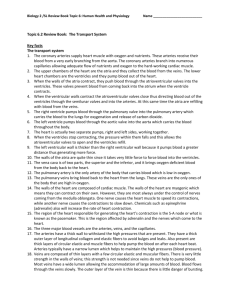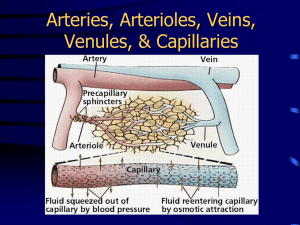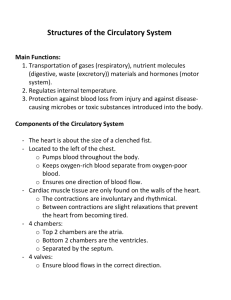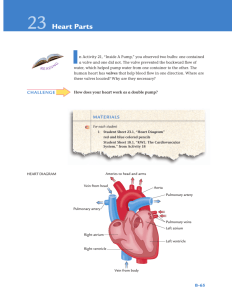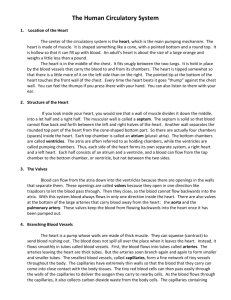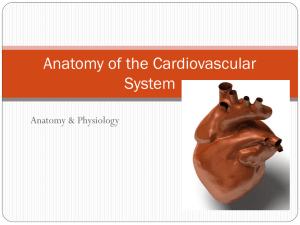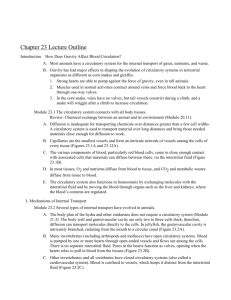Topic 6: Human health and physiology
advertisement
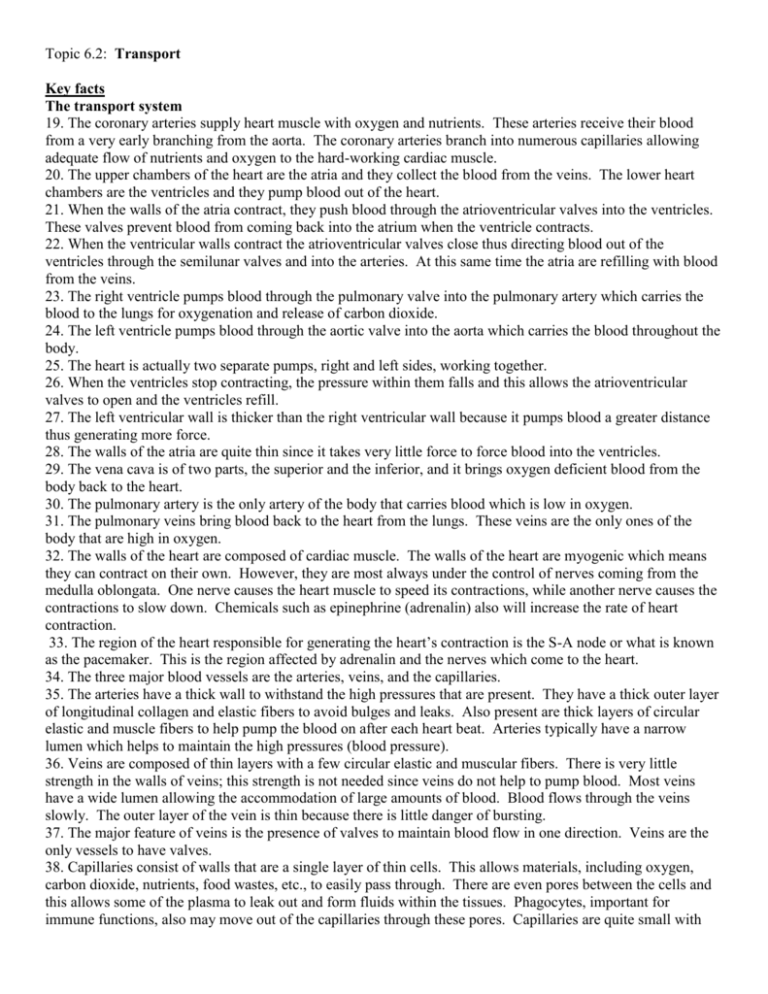
Topic 6.2: Transport Key facts The transport system 19. The coronary arteries supply heart muscle with oxygen and nutrients. These arteries receive their blood from a very early branching from the aorta. The coronary arteries branch into numerous capillaries allowing adequate flow of nutrients and oxygen to the hard-working cardiac muscle. 20. The upper chambers of the heart are the atria and they collect the blood from the veins. The lower heart chambers are the ventricles and they pump blood out of the heart. 21. When the walls of the atria contract, they push blood through the atrioventricular valves into the ventricles. These valves prevent blood from coming back into the atrium when the ventricle contracts. 22. When the ventricular walls contract the atrioventricular valves close thus directing blood out of the ventricles through the semilunar valves and into the arteries. At this same time the atria are refilling with blood from the veins. 23. The right ventricle pumps blood through the pulmonary valve into the pulmonary artery which carries the blood to the lungs for oxygenation and release of carbon dioxide. 24. The left ventricle pumps blood through the aortic valve into the aorta which carries the blood throughout the body. 25. The heart is actually two separate pumps, right and left sides, working together. 26. When the ventricles stop contracting, the pressure within them falls and this allows the atrioventricular valves to open and the ventricles refill. 27. The left ventricular wall is thicker than the right ventricular wall because it pumps blood a greater distance thus generating more force. 28. The walls of the atria are quite thin since it takes very little force to force blood into the ventricles. 29. The vena cava is of two parts, the superior and the inferior, and it brings oxygen deficient blood from the body back to the heart. 30. The pulmonary artery is the only artery of the body that carries blood which is low in oxygen. 31. The pulmonary veins bring blood back to the heart from the lungs. These veins are the only ones of the body that are high in oxygen. 32. The walls of the heart are composed of cardiac muscle. The walls of the heart are myogenic which means they can contract on their own. However, they are most always under the control of nerves coming from the medulla oblongata. One nerve causes the heart muscle to speed its contractions, while another nerve causes the contractions to slow down. Chemicals such as epinephrine (adrenalin) also will increase the rate of heart contraction. 33. The region of the heart responsible for generating the heart’s contraction is the S-A node or what is known as the pacemaker. This is the region affected by adrenalin and the nerves which come to the heart. 34. The three major blood vessels are the arteries, veins, and the capillaries. 35. The arteries have a thick wall to withstand the high pressures that are present. They have a thick outer layer of longitudinal collagen and elastic fibers to avoid bulges and leaks. Also present are thick layers of circular elastic and muscle fibers to help pump the blood on after each heart beat. Arteries typically have a narrow lumen which helps to maintain the high pressures (blood pressure). 36. Veins are composed of thin layers with a few circular elastic and muscular fibers. There is very little strength in the walls of veins; this strength is not needed since veins do not help to pump blood. Most veins have a wide lumen allowing the accommodation of large amounts of blood. Blood flows through the veins slowly. The outer layer of the vein is thin because there is little danger of bursting. 37. The major feature of veins is the presence of valves to maintain blood flow in one direction. Veins are the only vessels to have valves. 38. Capillaries consist of walls that are a single layer of thin cells. This allows materials, including oxygen, carbon dioxide, nutrients, food wastes, etc., to easily pass through. There are even pores between the cells and this allows some of the plasma to leak out and form fluids within the tissues. Phagocytes, important for immune functions, also may move out of the capillaries through these pores. Capillaries are quite small with very narrow lumen. Even though capillaries are extremely small, because they occur in such huge numbers they allow for an adequate exchange of materials between blood and body tissues. 2. Draw and label a diagram of the heart showing the four chambers, associated blood vessels, valves and the route of blood through the heart. Be certain to show relative wall thicknesses of the four chambers. Draw a diagram four chambers, vessels and of the heart showing all associated blood valves. What are the actions of the heart in terms of collecting blood, pumping blood and opening and closing valves? Outline the control of the heartbeat in terms of the pacemaker, nerves and adrenalin. What is the relationship between the structure and function of arteries, capillaries and veins? What is blood composed of? What are transported by the blood Artery- label what you see: Describe the structure and function of the arterial wall. Vein- label what you see: 1) How does venous tissue differ from arterial tissue? Examples of previous IB Exam questions w/ answers http://www.kenton.k12.ny.us/cms/lib/NY19000262/Centricity/Domain/361/IB%20Materials/QuestionsonTrans port.pdf 4
